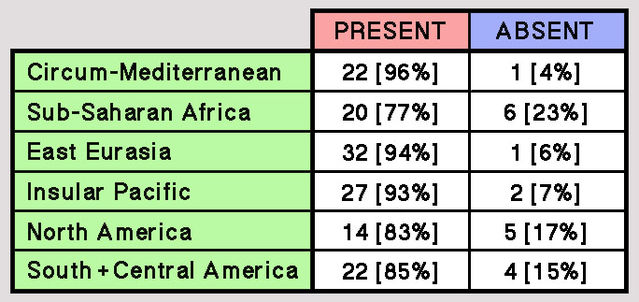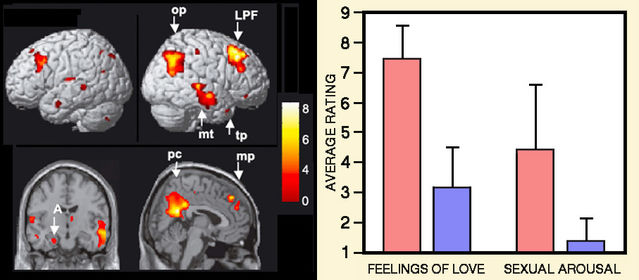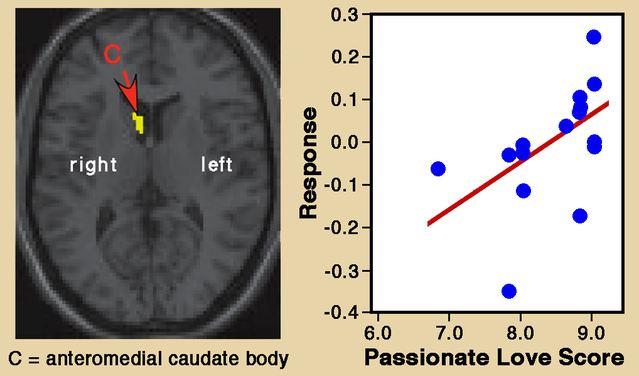Relationships
Romantic Love's Biological Foundations
Brain activity, chemical messengers, and nerve growth factor engaged in passion.
Posted February 12, 2020 Reviewed by Chloe Williams

Romantic love is a complex blend of erotic responses, emotions, mental functions, and behaviour. Although distinct, sexual arousal often occurs in tandem. Different kinds of love with some shared features exist, notably maternal rather than romantic. Romantic love — especially “at first sight” — establishes lasting pair-bonds. Note, however, that pair-bonds are not restricted to monogamy as an individual may have more than one. The issue of arranged marriages also arises. Infatuation, we are led to believe, is a necessary prelude to a loving marriage. Yet arranged marriages are no less successful over the long term than those that begin with two individuals spontaneously falling in love.
It has often been assumed that romantic love is confined to Euro-American culture. But a cross-cultural survey reported in 1992 by William Jankowiak and Edward Fisher confirmed that sudden passion with immediate commitment is actually a human universal and may hence have some biological basis. Appraisal of 166 human societies in six world regions indicated an overall average incidence of 88%, with a range from 77% in Africa to 96% in the circum-Mediterranean zone. Although Jankowiak and Fisher simply scored presence or absence, rather than how often romantic love occurs in individual societies, it is certainly not unique to Euro-American societies.

Love in brain scans
Scientific understanding of romantic love demands knowledge of brain processes. Fortunately, we can now use Functional Magnetic Resonance Imaging (fMRI), which monitors blood flow to detect brain activity accompanying behavioural responses. This approach has been used to explore various emotional states, both negative (e.g. fear, anger, anxiety, sadness) and positive (e.g. happiness, sexual arousal).
But brain activity accompanying the powerful agency of romantic love remained undocumented prior to a pioneering 2000 paper by Andreas Bartels and Semir Zeki. These researchers presented pictures of the romantic partners to 17 volunteers aged 21 to 37, who were “truly, deeply and madly in love” at the time, scanning their brains with fMRI while they viewed them. Each subject completed a questionnaire to receive a score on the widely used Passionate Love Scale. As a control, each subject’s brain was also scanned while viewing pictures of three friends of the same sex as the partner, with similar age and length of association.
Activation in response to pictures of a romantic partner occurred in specific localized areas on both sides of the brain. Deactivation also occurred, concentrated in localized areas in the right cortex of the brain. In combination, activation and deactivation differed from patterns identified in previous studies of other emotional states, so romantic love is associated with a unique network of brain areas.

Another paper published by Bartels and Zeki in 2004 expanded their investigation to compare romantic love with maternal love. They monitored brain activity with fMRI while mothers viewed pictures of their own children. As controls, each mother also viewed pictures of other familiar children, of her best friend and of familiar adults.
Brain activity associated with maternal attachment was compared with the previously described patterns accompanying romantic love. Activation patterns for specific brain areas — including overlapping regions in the brain's reward system rich in receptors for the hormones oxytocin and vasopressin — differed between romantic and maternal love. But both were accompanied by deactivation in a common set of brain regions associated with negative emotions, social judgment, and assessing other people's intentions and emotions. Bartels and Zeki concluded that both romantic and maternal love engage a “push-pull mechanism,” decreasing social distance by inactivating networks associated with negative factors, while employing the brain’s reward circuits to develop bonds.
Following Bartels and Zeki, from 2002 Helen Fisher and colleagues published a series of papers about brain systems connected with mating. They noted that in mammals and birds three primary emotion-motivation systems evolved for reproduction: sexual lust to initiate mating, attraction to preferred mating partners, and male-female attachment promoting parental care. In 1998, Fisher had noted that the sex drive is associated mainly with steroid hormones, the attraction system with two nerve transmitters (dopamine and norepinephrine), and the attachment system with oxytocin and vasopressin. Oxytocin — the “love hormone” — has been linked to pair-bonding in certain monogamous mammals. (See my blog post "Oxytocin — The Multitasking Love Hormone," posted May 12, 2015.)

Two 2005 papers by Helen Fisher and colleagues reported using fMRI to investigate brain circuits associated with romantic attraction. The first reported on reward, motivation, and emotion systems associated with early-stage romantic love. Ten women and seven men who were intensely in love alternately viewed a photograph of the beloved and a photograph of another familiar individual. Activation specific to the beloved occurred in dopamine-rich areas of the brain known to be associated with reward and motivation in mammals.
A second paper discussed further findings from that study, suggesting that dopamine-dependent pathways contribute to general arousal in romantic love. Subsequently, a 2006 paper by Fisher and colleagues reported results from an additional study of 15 men and women who had suffered rejection. Activity specific to the beloved was seen in regions of the reward system associated with high-stakes gambling, and in part of another region associated with obsessive/compulsive behaviour and anger control. The authors concluded that the brain mechanism underlying romantic attraction motivates individuals to focus courtship energy on specific individuals, facilitating mate choice and conserving energy.
Love molecules
Studies of romantic love by Enzo Emanuele and colleagues neatly complemented investigations of brain activity, beginning with their discovery of a link with Nerve Growth Factor (NGF). Initially, NGF became known for governing growth, proliferation, and maintenance of certain nerve cells. But it also serves other functions, for instance playing a key part in immune system regulation.
NGF also has connections with reproduction. It is abundant in semen and was recently shown to trigger egg release from the ovary (ovulation) in certain mammals. Biologists recognize two main groups of mammals: induced ovulators, with ovulation stimulated by mating, and spontaneous ovulators that ovulate independently of mating, due to a surge in the hormone LH. It has long been known that ovulation is induced in members of the camel family. Researchers eventually identified the active principle in the semen of alpacas and llamas, naming it Ovulation-Inducing Factor (OIF). Then, in a surprising twist, Marcelo Ratto and others reported in 2012 that OIF is actually identical to NGF!

The key finding reported by Enzo Emanuele and colleagues in 2006 is that during the first year of a romantic relationship blood levels of NGF are more than 50% above baseline. They compared 58 subjects who had recently fallen in love with two control groups, one containing single people and the other consisting of individuals already engaged in long-lasting relationships. Of four nerve factors tested, NGF alone showed higher blood levels during the early phase of a romantic relationship.
Emanuele and colleagues also found that NGF levels were positively associated with scores on the Passionate Love Scale. But data points are widely scattered, so additional factors clearly influence love intensity. As a sequel, 39 subjects originally examined in the early phase of a romantic relationship were retested one to two years later, still in the same relationship but less intensely in love. Their blood levels of NGF had decreased, becoming indistinguishable from the two control groups.
In a subsequent paper published in 2007, Emanuele and others reported results of exploring potential links between romantic love and markers for genes that produce chemical messengers for brain function. They tested 350 young adults of both sexes to allocate them to six love styles defined in John Lee’s 1976 book, The Colors of Love. They then sought associations with six markers of genes for dopamine and serotonin (another chemical messenger). A significant association was found between one dopamine gene marker and Lee’s Eros loving style, which involves powerful attraction. A second association was identified between a serotonin gene marker and Lee’s Mania style, involving emotional dependency.
Cupid’s arrow
It is truly remarkable that within the space of just twenty years a wealth of new knowledge has been gathered concerning biological processes in romantic love. New techniques have permitted documentation of localized brain regions, chemical messengers, nerve growth factors, hormones, and genetic influences that all contribute to the exhilarating state of infatuation. But let us not forget that the complex interaction with cultural processes that typifies human behaviour generates a glorious variety that only poetry can capture.
I am grateful to Semir Zeki, Helen Fisher, and Enzo Emanuele for feedback on a draft version and for giving permission to use redrawn figures from their papers.
References
Aron, A., Fisher, H.E., Mashek, D., Strong, G., Li, H. & Brown, L.L. (2005) Reward, motivation and emotion systems associated with early-stage intense romantic love. Journal of Neurophysiology 94:327-337.
Bartels, A. & Zeki, S. (2000) The neural basis of romantic love. NeuroReport 11:3829-3834.
Bartels, A. & Zeki, S. (2004) The neural correlates of maternal and romantic love. NeuroImage 21:1155-1166.
Emanuele, E., Brondino, N., Pesenti, S., Re, S. & Geroldi, D. (2007) Genetic loading on human loving styles. Neuroendocrinology Letters 28:815-821.
Emanuele, E., Polliti, P., Bianchi, M., Minoretti, P., Bertona, M. & Geroldi, D. (2006) Raised plasma nerve growth factor levels associated with early-stage romantic love. Psychoneuroendocrinology 31:288-294.
Fisher, H.E. (1998) Lust, attraction, and attachment in mammalian reproduction. Human Nature 9:23-52.
Fisher, H.E., Aron, A. & Brown, L.L. (2005) Romantic love: an fMRI study of a neural mechanism for mate choice. Journal of Comparative Neurology 493:58-62.
Fisher, H.E., Aron, A. & Brown, L.L. (2006) Romantic love: a mammalian brain system for mate choice. Philosophical Transactions of the Royal Society of London B 361:2173-2186.
Fisher, H.E., Aron, A., Mashek, D., Li, H. & Brown, L.L. (2002) Defining the brain systems of lust, romantic attraction, and attachment. Archives of Sexual Behavior 31:413-419.
Jankowiak, W.R. & Fisher, E.F. (1992) A cross-cultural perspective on romantic love. Ethnology 31:149-155.
Ratto, M.H., Leduc, Y.A., Valderrama, X.P., Van Straten, K.E., Delbaere, L.T, Pierson, R.A. & Adams, G.P. (2012) The nerve of ovulation-inducing factor in semen. Proceedings of the National Academy of Sciences U.S.A. 109:15042-15047.
Zeki, S. (2007) The neurobiology of love. FEBS Letters 581:2575-2579.




